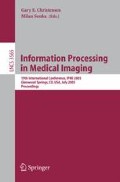Abstract
This paper presents a novel non-rigid registration method. The main contribution of the method is the modeling of the vorticity (respectively divergence) of the deformation field using vortex (respectively sink and source) particles. Two parameters are associated with a particle: the vorticity (or divergence) strength and the influence domain. This leads to a very compact representation of vorticity and divergence fields. In addition, the optimal position of these particles is determined using a mean shift process. 2D experiments of this method are presented and demonstrate its ability to recover evolving phenomena (MS lesions) so as to register images from 20 patients.
Access this chapter
Tax calculation will be finalised at checkout
Purchases are for personal use only
Preview
Unable to display preview. Download preview PDF.
References
Chorin, A.: Numerical study of slightly viscous flow. J. Fluid Mech. 57, 785–796 (1973)
Comaniciu, D., Meer, P.: Mean shift: A robust approach toward feature space analysis. IEEE PAMI 24(5), 603–619 (2002)
Fukanaga, K., Hostetler, L.D.: The estimation of the gradient of a density function, with applications in pattern recognition. IEEE Trans. on Info. Theory 21(1), 32–40 (1975)
Leonard, A.: Vortex methods for flow simulation. J. Comp. Phys. 37 (1980)
Lester, H., Arridge, S.: A survey of hierarchical non-linear medical image registration. Pattern Recognition 32, 129–149 (1999)
Maes, F., Collignon, A., Vandermeulen, D., Marchal, G., Suetens, P.: Multimodality image registration by maximisation of mutual information. IEEE TMI 16(2), 187–198 (1997)
Maintz, J., Viergever, M.A.: A survey of medical image registration. MedIA 2(1), 1–36 (1998)
Smith, S.M.: Fast robust automated brain extraction. HBM 17(3), 143–155 (2002)
Thisted, R.A.: Elements of statistical computing. Chapman and Hall, Boca Raton (1988)
Toga, A., Thompson, P.: The role of image registration in brain mapping. Image and Vision Computing 19, 3–24 (2001)
Zitova, B., Flusser, J.: Image registration methods: a survey. Image and Vision Computing 21, 977–1000 (2003)
Author information
Authors and Affiliations
Editor information
Editors and Affiliations
Rights and permissions
Copyright information
© 2005 Springer-Verlag Berlin Heidelberg
About this paper
Cite this paper
Cuzol, A., Hellier, P., Mémin, E. (2005). A Novel Parametric Method for Non-rigid Image Registration. In: Christensen, G.E., Sonka, M. (eds) Information Processing in Medical Imaging. IPMI 2005. Lecture Notes in Computer Science, vol 3565. Springer, Berlin, Heidelberg. https://doi.org/10.1007/11505730_38
Download citation
DOI: https://doi.org/10.1007/11505730_38
Publisher Name: Springer, Berlin, Heidelberg
Print ISBN: 978-3-540-26545-0
Online ISBN: 978-3-540-31676-3
eBook Packages: Computer ScienceComputer Science (R0)

